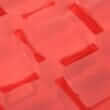Background
- Gelatin is a protein substance used to thicken liquids. It does not have a color, smell, or taste. It comes from boiling animal tissues such as beef bones, cartilage, tendons, and pig skin. Gelatin is used in many kinds of food products and drug and supplement products. Common examples of foods that contain gelatin are gelatin desserts, jelly, trifles, aspic, marshmallows, and candies such as "peeps" and gummy bears. Gelatin may be used to add thickness or texture to foods, finishing agents, ice cream, jams, yogurt, cream cheese, fruit juices, wine, beer, or margarine. Different types and grades of gelatin are used in a wide range of food and nonfood products.
- In the pharmaceutical industry, gelatin is used as the substance that holds the active drug in vaccines and other medications. It is also used as a binder for tablets and suppositories. Gelatin capsules (gelcaps) are often used to hold various foods, nutritional supplements, and medicines.
- In medicine, gelatin is taken by mouth for conditions like joint disease, arthritis (joint stiffness and inflammation), osteoporosis (weakening of the bones), skin and hair care, and weight loss. Early information suggests that an agent that contains gelatin with fresh frozen plasma (a blood substitute) may help prevent death in premature infants.
- More research is needed on the effect of gelatin for use in disease conditions.
References
- Fletcher AG, Hardy, JD, Riegel C, et al. Gelatin as a plasma substitute: the effects of intravenous infusion of gelatin on cardiac output and other aspects of the circulation of normal persons, of chronically ill patients, and of normal volunteers subjected to large hemorrhage. J Clin Invest 1945;24(4):405-415. View Abstract
- Kallinteri P, Antimisiaris SG. Solubility of drugs in the presence of gelatin: effect of drug lipophilicity and degree of ionization. Int.J Pharm. 6-19-2001;221(1-2):219-226. View Abstract
- Kawahara H, Tanaka K, Iikura Y, et al. The incidence of gelatin allergy among atopic children in Japan. J Allergy Clin Immunol 1998;103:321-325.
- Laxenaire M, Charpentier C, Feldman L, et al. Anaphylactoid reactions to colloid plasma substitutes: incidence, risk factors, mechanisms. A French multicenter prospective study. Ann Fr Anesth Reanim 1994;13(3):301-310. View Abstract
- Morganti P, Randazzo S, Bruno C. Effect of gelatin/cystine diet on human hair growth. J Soc Cosmetic Chem (England) 1982;33:95-96.
- Morganti, P and Fanrizi, G. Effects of gelatin-glycine on oxidative stress. Cosmetics and Toiletries (USA) 2000;115:47-56.
- Moskowitz, R. W. Role of collagen hydrolysate in bone and joint disease. Semin Arthritis Rheum 2000;30(2):87-99. View Abstract
- Nakayama T, Aizawa C, Kuno-Sakai H. A clinical analysis of gelatin allergy and determination of its causal relationship to the previous administration of gelatin-containing acellular pertussis vaccine combined with diphtheria and tetanus toxoids. J Allergy Clin Immunol 1999;103(2 Pt 1):321-325. View Abstract
- No authors listed. A randomized trial comparing the effect of prophylactic intravenous fresh frozen plasma, gelatin or glucose on early mortality and morbidity in preterm babies. The Northern Neonatal Nursing Initiative [NNNI] Trial Group. Eur J Pediatr 1996;155(7):580-588. View Abstract
- Pearson D. Joint health: glucosamine and gelatin. Strength and Conditioning J 2000;22(2):671.
- Sakaguchi M, Nakayama T, Fujita H, et al. Minimum estimated incidence in Japan of anaphylaxis to live virus vaccines including gelatin. Vaccine 10-15-2000;19(4-5):431-436. View Abstract
- Sakaguchi M, Nakayama T, Inouye S. Food allergy to gelatin in children with systemic immediate-type reactions, including anaphylaxis, to vaccines. J Allergy Clin Immunol 1996;98(6 Pt 1):1058-1061. View Abstract
- Stratton, C. W., Weinstein, M. P., Mirrett, S., Paisley, J., Lauer, B. A., and Reller, L. B. Controlled evaluation of blood culture medium containing gelatin and V-factor-analog for detection of septicemia in children. J Clin Microbiol 1988;26(4):747-749. View Abstract
- van Eerd JE, Vegt E, Wetzels, JF, et al. Gelatin-based plasma expander effectively reduces renal uptake of 111In-octreotide in mice and rats. J Nucl Med 2006;47(3):528-533. View Abstract







